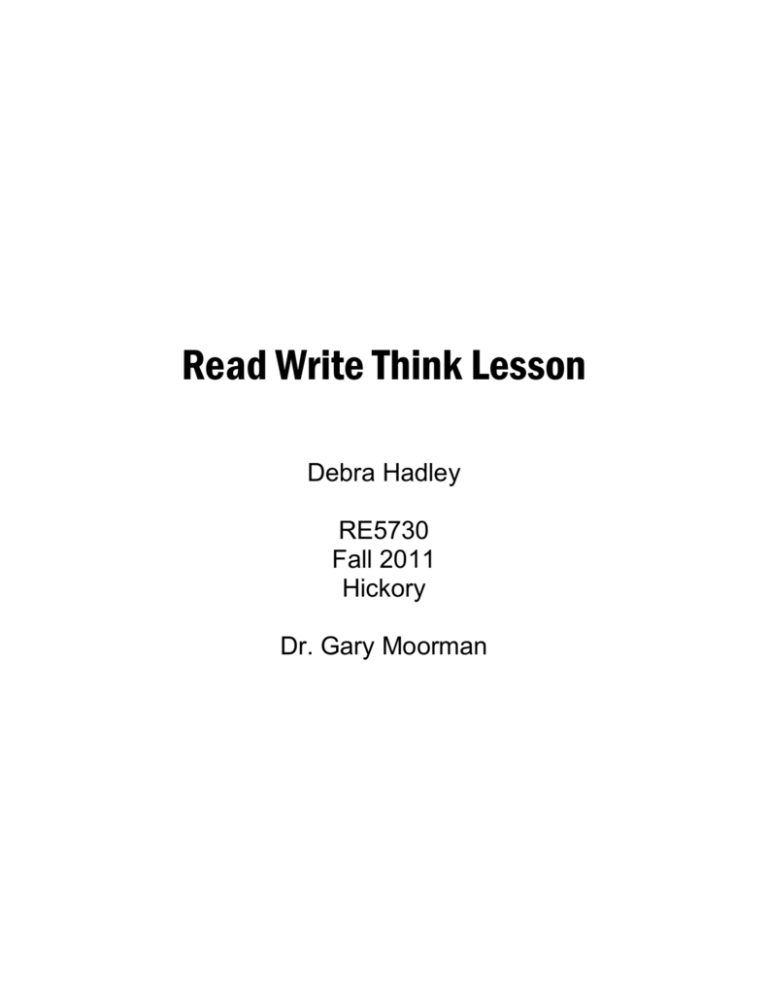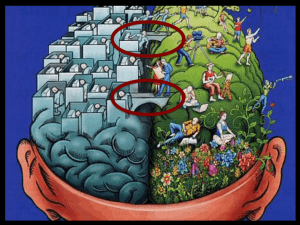ReadWriteThink Lesson
advertisement

Read Write Think Lesson Debra Hadley RE5730 Fall 2011 Hickory Dr. Gary Moorman Lesson Title Entrepreneurship is for the brave, and it’s full of jargon. Grade 9-12 Lesson type Standard Lesson Learning Objectives Collaboration, Comprehension, Oral Communication, Vocabulary Themes Nonfiction Keywords Entrepreneurship, entrepreneur, small business, business plan, marketing, feasibility analysis, marketing mix, business owner, products or services, inventory, markup, and profit and loss. Brief Description Students will explore the vocabulary of entrepreneurship and business practice. Overview This lesson will introduce students to the key vocabulary of Entrepreneurship as a part of the ultimate goal of conducting a food-based business in the school setting. The challenge of this unit is that students have very little, if any, existing knowledge upon which to build what one needs to teach them. That deficit must be addressed. Explicit instruction in the vocabulary needed to understand the curriculum concepts is critical. In the companion lessons for this master unit, students will study entrepreneurship through readings, videos and Webpages. For these lessons, vocabulary lists are organized by theme. Students explore and solidify their knowledge of the terms through hands-on work with the words through booklets and foldables and interactive work online. The companion lessons will use and reinforce the vocabulary terms. Featured Resources www.readwritethink.org – ReadWriteThink interactives: Flip Book and Stapleless Book. These student activities will let students make their own reference text for some of the numerous business terms they need to know to converse about this subject and master the material for the required state test at the end of the term. http://www.mentalengineering.com/ – DVD or online streaming of the Public Broadcasting Service distributed show, “Mental Engineering.” This show will give students a live example of marketing and then let them see it deconstructed with thought for what its goals and absurdities are. Wordles, Word Sift, and an online dictionary. o visual.merriam-webster.com/index.php o www.wordle.net o www.wordsift.com Students will use these interactive to work with and give thought to their vocabulary terms. www.discoveryeducation.com Online puzzle maker. This webpage will allow students to construct a crossword puzzle after a focusing activity with the terms. From theory to practice Labbo, L. D., Love, M. S., & Ryan, T. (2007). A vocabulary flood: Making words “sticky” with computer-response activities. Reading Teacher, 60(6), 582-588. doi:10.1598/RT.60.6.10 Students from low socio-economic households often lack the rich vocabulary necessary to perform well on academic tasks. School-based reading does not seem to provide the rich association necessary to integrate new words into a weaker reader’s long-term vocabulary. Structured activities are conducted over several days. Activities are designed to build rich associations and encourage students to work with and think deeply about new vocabulary words in content reading to make the new words more “sticky” – that is more likely to be remembered. Dalton, B., & Grisham, D. L. (2011). eVoc Strategies: 10 Ways to Use Technology to Build Vocabulary. Reading Teacher, 64(5), 306-317. doi:10.1598/RT.64.5.1 Studies have shown a high correlation between vocabulary knowledge and reading comprehension. The “Matthew effect” notes that strong readers get stronger and weak readers get weaker over time in school settings. Vocabulary instruction is important to help close the achievement gap. Using technology can draw Millennial students into an engaged study of words by using digital interactives. Standards IRA: 3, 8, 11, 12 N.C. Standard Course of Study Foods II: Standard 12 Analyze a product for a live entrepreneurial project. Obj. 12.01 Summarize Project Concerns and Options Obj. 12.02 Set Goals for an Entrepreneurial Project within the Classroom Obj. 12.03 Plan an Entrepreneurial Project within the Classroom Resources Materials and technology Projector/WhiteScreen, Whiteboard or other way to demonstrate work/webpages to class Computers with Internet access and printer access DVD of PBS show, “Mental Engineering,” or access to online clips through computer connected to white screen or Smart Board. Classroom set of textbook “Entrepreneurship and Small Business Management” Student interactives ReadWriteThink: Flip Book, Stapleless book, webpage for Wordles and Crossword Puzzle Maker Printouts Vocabulary Lists by theme (four sets) Guiding questions for creating Stapleless Book for Voc. Set No. 1 Guiding questions for creating Wordles with Voc. Set No. 2 Guiding questions for creating a CrissCross (Crossword) Puzzle using online puzzle maker. Websites Crossword Puzzle maker http://www.discoveryeducation.com/freepuzzlemaker/?CFID=64337&CFTOKEN=32313788 Visual dictionary visual.merriam-webster.com/index.php Online word concept mapping tool www.wordle.net Online word concept mapping tool www.wordsift.com Estimated Lesson Time 5 (90-minute) class periods (can be broken into smaller segments if desired) Student Objectives Students will: learn the meaning of the basic entrepreneurship terms used in the unit use the terms and concepts in carrying out the ultimate goal of operating a foodsbased business in the school setting understand the terms so they can be used in crafting a standard business plan, a portfolio and a presentation. Preparation 1. Assemble a Wordle using entrepreneurship as the key word. Pring it to show to students before the class assembles a Wordles on the terms. 2. Preview the websites students will be asked to use. 3. Obtain a DVD copy or preview online and select a 5- to 6-minute segment of the T.V. show “Mental Engineering.” 4. Reserve computer lab time if necessary. 5. Assemble copies of student handouts. (Definition sheets may be used as classroom sets to conserve paper/copies.) Instruction and activities Lesson One 1. Introduce the topic of Entrepreneurship by asking students what they know about it. This could be done in a brainstorming session, anticipation guide or other desired format. Talk about Entrepreneurship and explain that the students are about to become Entrepreneurs. Explain about the party offer. (If the foods-based business makes $100 in profit, $50 of it will buy them a party.) 2. Explain to students that to succeed in business and on the end-of-course test, there are approximately 50 vocabulary terms they need to be able to use. Use means to know what it means, be able to describe how it works and understand its relationship to the other words and the work they will be doing. Explain that the words will be presented in four 3. 4. 5. 6. 7. 8. sets of about 10 words that are related. Studying words that are related will help them define, remember and use the words correctly. Explain that we will be doing a variety of interactive things as we discuss and use these words. Ask students how many businesses are in America. (The U.S. Small Business Administration says there are 27.5 million businesses in America and 99 percent of them are small businesses with 500 or fewer employees. The U.S. Department of Commerce reports that 75 percent of American businesses have no employees. These are people who are self-employed.) Discuss/react. The U.S. Dept. of Commerce site to show if desired is: http://www.census.gov/econ/smallbus.html. Ask students how many small businesses fail in America. (SBA rates show that about half of new businesses started each year fail or close within the first four years.) So this entrepreneurship is very risky business. Review the words on the first list of terms (Business Plan and Basic Terms Set. No. 1). Ask students if they know what any of the terms mean. Pass out the definition sheets. (Note: It is wise to give students a good solid definition to start. Students, especially those with weak vocabulary, often compile incomplete, random or incorrect definitions. Giving them the definitions also bypasses the tedious task of group review or (horrors) the teacher checking each student’s work on definitions for quality and accuracy. Students will create two Stapleless Books that list each term and show the most important parts of the definition. There is a list of guiding questions to direct students in picking out the most important points to include with each term. The handout includes complete instructions for carrying out the activity. Students may complete the books in one sitting or two – as instructor desires. Lesson Two 1. Introduce the concept that guides this set of terms – Cost and Marketing (Set No. 2). Ask the students what they know about cost. Discuss and correct any misconceptions. Ask students what they know about marketing. Discuss and correct any misconceptions. 2. Explain that they are about to see one of the biggest tools for marketing in America – the T.V. commercial. This show takes commercials and picks them apart with analysis and humor. 3. Show students one five or six minute clip of the television show “Mental Engineering.” The show starts with the commercial. Stop the video at the end of the commercial, and ask students to discuss how effective the commercial was. Have students write down one way they think the commercial was designed to “market” the product and who it “targets” as its customer. Students will share in pairs and then in class discussion. 4. Show the panel analysis of the commercial. Have students write down one point that they thought was particularly good from the analysis. Share with a neighbor. Class discussion can follow. 5. Raise the question and discuss, “Why is the show called “Mental Engineering”? 6. Count students off in groups of two or three. Pass out definition sheets. Ask students to read definitions out loud in their groups. 7. Pass out activity sheet with guiding questions. Model a Wordle on the white screen. Go over instructions and allow groups to create a Wordle for each vocabulary term. 8. This activity may need to be broken up into smaller sections over two days for maximum creativity and retention of terms. 9. Groups can print and bind their Wordles into a booklet to use in other classroom work. Lesson Three 1. Introduce the concept that guides this set of terms – Inventory Management Along With Some Random Terms. (Note: Some of the questions on the classroom item banks are random and so these terms and questions are taught explicitly as random terms.) 2. Question the students about their knowledge of inventory management and why it is necessary. 3. Note to students that inventory management is directly related to costs. Costs were in our previous set of terms. Good inventory management leads to lower supply costs. Businesses pay for inventory (supplies) with cash money, and therefore it is important to turn that inventory into product and sell it to make a profit so the whole cycle can start again. 4. Quickly go over the terms on the definition sheets. Pass out sheets to students and model the flip book on the white screen. 5. The link is http://www.readwritethink.org/classroom-resources/student-interactives/flipbook-30054.html. 6. Ask the students to use the computers to make their own flip books. They may type the material and print, or they can print a blank flip book and write and draw by hand. 7. Give students time to compile their own books while monitoring the quality of the work and time on task. Lesson Four 1. By now, even the most unobservant student will have noticed a pattern in the vocabulary introduction work. Introduce the new set of terms to the students by telling them that this is the last set. Cheering from the crowd is most appropriate. Explain to them that this set is focused on “The Business of Business plus Profits.” 2. Business is just like everything else in life. It is run according to human nature, and patterns emerge because people face the same issues, problems and needs. There are principles and rules that have developed over time because of human nature and these patterns. 3. The whole purpose of a business is to make money (unless you are a social entrepreneur). So the rules and principles have developed to help businesses keep track of what they are doing (operations), how much they are spending to do it (financials) and whether or not in the end they are making any money (a profit). 4. Students will make their own crossword puzzle to work with their definitions. They will then swap with another student and solve a crossword. 5. Demonstrate the crossword puzzle activity on the white screen for the students. Pass out the definition sheets. Do a quick run through of the terms. 6. Set the students to work on their crossword puzzles. 7. The crossword puzzle link is http://www.discoveryeducation.com/freepuzzlemaker/?CFID=64337&CFTOKEN=32313788. Extensions This work will be logically extended into other classroom and kitchen laboratory activities as study of Entrepreneurship continues. Students will also: o View and respond to the DVD “These Kids Mean Business” a PBS documentary on teen entrepreneurs. o Test prototypes of food products to sell o Figure cost, markup and a retail price for their product o Make a formal business plan based on our studies and their manufacturing and sales work. o Compile a portfolio documenting their process and learning during this unit. o Turn the portfolio into a 6- to 8-minute oral presentation with visuals. Pair with the business or marketing classes to discuss and implement marketing strategies for the business. Record an advertisement for the morning announcements to promote the business. Visit middle school classrooms and give presentations to extend the learning and give the students an authentic audience for their work. Encourage students to purchase “whites” (chef coats) for their work in lab and as they move around the school selling their products. Student Assessments/Reflections Daily Work (Participation, Completion, Formative Assessment, Work Check) grades can be taken on any of the supporting work that students do. To eliminate paperwork overload, institute a reduced point system and walk around to check student’s work instead of taking it up. The reduced point system works like this – establish a point value for each daily work grade – for instance 10 points. For each piece of work evaluated the student can earn 0, 5, or 10 points. Record these grades on a grid. A separate page in the paper grade book works well for this. When students have had 10 (or to help them 11 or 12) attempts to earn 100 points, count up their points and record one daily work grade in the electronic grade book. This allows teachers to do a lot of formative assessment without being bogged down by paperwork. It is feasible and even easy to take 3 grades each day in a 90-minute class period without touching a single student paper. Students can regularly record their thoughts, successes, failures, and plans on the work as it proceeds in a Response Journal. Assess the business plan using the rubric provided to students. Assess the presentations using the rubric provided to the students. Give the state-provided test from the item bank of Foods 2 Obj. 12 questions. There are 84 questions.







